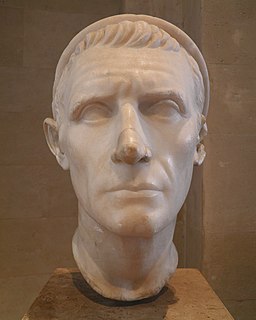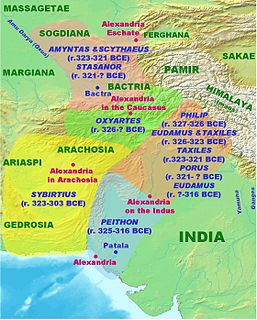Related Research Articles

Alexander I Theopator Euergetes, surnamed Balas, was the ruler of the Greek Seleucid kingdom in 150/Summer 152 – August 145 BC. Alexander defeated Demetrius I Soter for the crown in 150 BC. Ruling briefly, he lost the crown to Demetrius II Nicator during his defeat at the Battle of Antioch in Syria, dying shortly after. His reign marks the beginning of the disintegration of the Seleucid realm, with important eastern satrapies such as Media being lost to the nascent Parthian Empire.

The Seleucid Empire was a Greek state in Western Asia, during the Hellenistic Period, that existed from 312 BC to 63 BC. The Seleucid Empire was founded by Seleucus I Nicator, following the division of the Macedonian Empire that existed previously, which had been founded by Alexander the Great.

Miletus was an ancient Greek city on the western coast of Anatolia, near the mouth of the Maeander River in ancient Ionia. Its ruins are located near the modern village of Balat in Aydın Province, Turkey. Before the Persian rule that started in the 6th century BC, Miletus was considered among the greatest and wealthiest of Greek cities.

Demetrius III Theos Philopator Soter Philometor Euergetes Callinicus was a Hellenistic Seleucid monarch who reigned as the King of Syria between 96 and 87 BC. He was a son of Antiochus VIII and, most likely, his Egyptian wife Tryphaena. Demetrius III's early life was spent in a period of civil war between his father and his uncle Antiochus IX, which ended with the assassination of Antiochus VIII in 96 BC. After the death of their father, Demetrius III took control of Damascus while his brother Seleucus VI prepared for war against Antiochus IX, who occupied the Syrian capital Antioch.

Antiochus II Theos was a Greek king of the Hellenistic Seleucid Empire who reigned from 261 to 246 BC. He succeeded his father Antiochus I Soter in the winter of 262–61 BC. He was the younger son of Antiochus I and princess Stratonice, the daughter of Demetrius Poliorcetes.

Antiochus III the Great was a Greek Hellenistic king and the 6th ruler of the Seleucid Empire. He ruled over the region of Syria and large parts of the rest of western Asia towards the end of the 3rd century BC. Rising to the throne at the age of eighteen in 222 BC, his early campaigns against the Ptolemaic Kingdom were unsuccessful, but in the following years Antiochus gained several military victories and substantially expanded the empire's territory. His traditional designation, the Great, reflects an epithet he assumed. He also assumed the title Basileus Megas, the traditional title of the Persian kings. A militarily active ruler, Antiochus restored much of the territory of the Seleucid Empire, before suffering a serious setback, towards the end of his reign, in his war against Rome.

{{Infobox royalty | name = Seleucus I

Alexander II Theos Epiphanes Nikephoros was a Hellenistic Seleucid monarch who reigned as the King of Syria between 128 BC and 123 BC. His true parentage is debated; depending on which ancient historian, he either claimed to be a son of Alexander I or an adopted son of Antiochus VII. Most ancient historians and the modern academic consensus maintain that Alexander II's claim to be a Seleucid was false. His surname "Zabinas" (Ζαβίνας) is a Semitic name that is usually translated as "the bought one". It is possible, however, that Alexander II was a natural son of Alexander I, as the surname can also mean "bought from the god". The iconography of Alexander II's coinage indicates he based his claims to the throne on his descent from Antiochus IV, the father of Alexander I.

Antiochus XII Dionysus Epiphanes Philopator Callinicus was a Hellenistic Seleucid monarch who reigned as King of Syria between 87 and 82 BC. The youngest son of Antiochus VIII and, most likely, his Egyptian wife Tryphaena, Antiochus XII lived during a period of civil war between his father and his uncle Antiochus IX, which ended with the assassination of Antiochus VIII in 96 BC. Antiochus XII's four brothers laid claim to the throne, eliminated Antiochus IX as a claimant, and waged war against his heir Antiochus X.

Antiochus X Eusebes Philopator was a Seleucid monarch who reigned as king of Syria during the Hellenistic period between 95 BC and 92 BC or 89/88 BC. He was the son of Antiochus IX and perhaps his Egyptian wife Cleopatra IV. He lived in a period during which there was a general disintegration of Seleucid Syria characterized by civil wars, foreign interference by Ptolemaic Egypt and incursions by the Parthians. Antiochus IX was killed in 95 BC at the hands of Seleucus VI, the son of his half-brother and rival Antiochus VIII. Antiochus X then went to the city of Aradus where he declared himself king. He avenged his father by defeating Seleucus VI, who was eventually killed.

Philip I Epiphanes Philadelphus was a Hellenistic Seleucid monarch who reigned as the King of Syria from 94 to either 83 or 75 BC. The son of Antiochus VIII and his wife Tryphaena, he spent his early life in a period of civil war between his father and his uncle Antiochus IX. The conflict ended with the assassination of Antiochus VIII and a quick succession in the Syrian capital Antioch of Antiochus IX then Antiochus VIII's eldest son Seleucus VI.

Seleucus VI Epiphanes Nicator was a Hellenistic Seleucid monarch who ruled Syria between 96 and 94 BC. He was the son of Antiochus VIII and his Egyptian wife Tryphaena. Seleucus VI lived in a period of civil war between his father and his uncle Antiochus IX, which ended in 96 BC when Antiochus VIII was assassinated. Antiochus IX then occupied the capital Antioch while Seleucus VI established his power-base in western Cilicia and himself prepared for war. In 95 BC, Antiochus IX marched against his nephew, but lost the battle and was killed. Seleucus VI became the master of the capital but had to share Syria with his brother Demetrius III, based in Damascus, and his cousin, Antiochus IX's son Antiochus X.

Philip II Philoromaeus or Barypous, a ruler of the Hellenistic Seleucid Empire, was the son of the Seleucid king Philip I Philadelphus, and the last Seleucid king.

The Hellenistic period spans the period of Mediterranean history between the death of Alexander the Great in 323 BC and the emergence of the Roman Empire, as signified by the Battle of Actium in 31 BC and the conquest of Ptolemaic Egypt the following year. The period of Greece prior to the Hellenistic era is known as Classical Greece, while the period afterwards is known as Roman Greece. The Ancient Greek word Hellas was originally the widely recognized name of Greece, from which the word Hellenistic was derived. "Hellenistic" is distinguished from "Hellenic" in that the first encompasses all territories under direct ancient Greek influence, while the latter refers to Greece itself. Instead, the term "Hellenistic" refers to that which is influenced by Greek culture, in this case, the East after the conquests of Alexander the Great.

Theodor Wiegand was one of the more famous German archaeologists.

The Seleucid–Mauryan War was fought between 305 and 303 BCE. It started when Seleucus I Nicator, of the Seleucid Empire, sought to retake the Indian satrapies of the Macedonian Empire which had been occupied by Emperor Chandragupta Maurya, of the Maurya Empire.
Philocles was King of Sidon and a military commander under the Ptolemaic dynasty in the late 4th and early 3rd century BC, and one of the architects of Ptolemaic imperialism in the coasts of Asia Minor and the Aegean Sea. He served as an admiral in the Ptolemaic navy during the Second Syrian War.
The Ptolemaic navy was the naval force of the Ptolemaic Kingdom and later empire from 305 to 30 BC. It was founded by King Ptolemy I. Its main naval bases were at Alexandria, Egypt and Nea Paphos in Cyprus. It operated in the East Mediterranean in the Aegean Sea, the Levantine Sea, but also on the river Nile and in the Red Sea towards the Indian Ocean.
References
Citations
- ↑ Grainger 1997, p. 810.
- ↑ Herrmann 1998, p. 6.
- ↑ Brückner et al. 2014, p. 81.
- ↑ Pleket & Stroud 1990, p. 319.
- ↑ Chaniotis 1987, p. 41.
- ↑ Herrmann 1987, p. 183.
- 1 2 3 4 Kosmin 2014, p. 112.
Sources
- Brückner, Helmut; Herda, Alexander; Müllenhoff, Marc; Rabbel, Wolfgang; Stümpel, Harald (2014). Frederiksen, Rune; Handberg, Søren (eds.). "On the Lion Harbour and other Harbours in Miletos: Recent Historical, Archaeological, Sedimentological, and Geophysical Research". Proceedings of the Danish Institute at Athens. Arhus University Press. 7. ISBN 978-8-771-24104-4. ISSN 1108-149X.
- Grainger, John D. (1997). A Seleukid Prosopography and Gazetteer. Mnemosyne, Bibliotheca Classica Batava. Supplementum. Vol. 172. Brill. ISBN 978-9-004-10799-1. ISSN 0169-8958.
- Kosmin, Paul J. (2014). The Land of the Elephant Kings: Space, Territory, and Ideology in the Seleucid Empire. Harvard University Press. ISBN 978-0-674-72882-0.
- Herrmann, Peter (1987). "Milesier am Seleukidenhof. Prosopographische Beiträge zur Geschichte Milets im 2. Jhdt. v. Chr". Chiron: Mitteilungen der Kommission für Alte Geschichte und Epigraphik des Deutschen Archäologischen Instituts (in German). Verlag C.H.Beck. 17. ISSN 0069-3715.
- Chaniotis, Angelos (1987). "Ein Neuer Genealogischer Text aus Milet". Epigraphica Anatolica (in German). Dr. Rudolf Habelt GmbH. 10. ISSN 0174-6545.
- Herrmann, Peter (1998). "n. 422". Inschriften von Milet (in German). Walter de Gruyter (Deutsches Archäologisches Institut). Teil 2 Inschriften n. 407-1019 (Milet: Ergebnisse der Ausgrabungen und Untersuchungen seit dem Jahr 1899 V1/2). ISBN 978-3-11-015092-6. ISSN 2304-4934.
- Pleket, Henri Willy; Stroud, Ronald S., eds. (1990). "SEG 37-992. Miletos. Epitaph of the Nauarchos Antigonos and his Family, ca. 100 B.C. or Somewhat Later". Supplementum Epigraphicum Graecum. Sijthoff & Noordhoff. XXXVII (1987). ISBN 978-9-004-16849-7. ISSN 0920-8399.